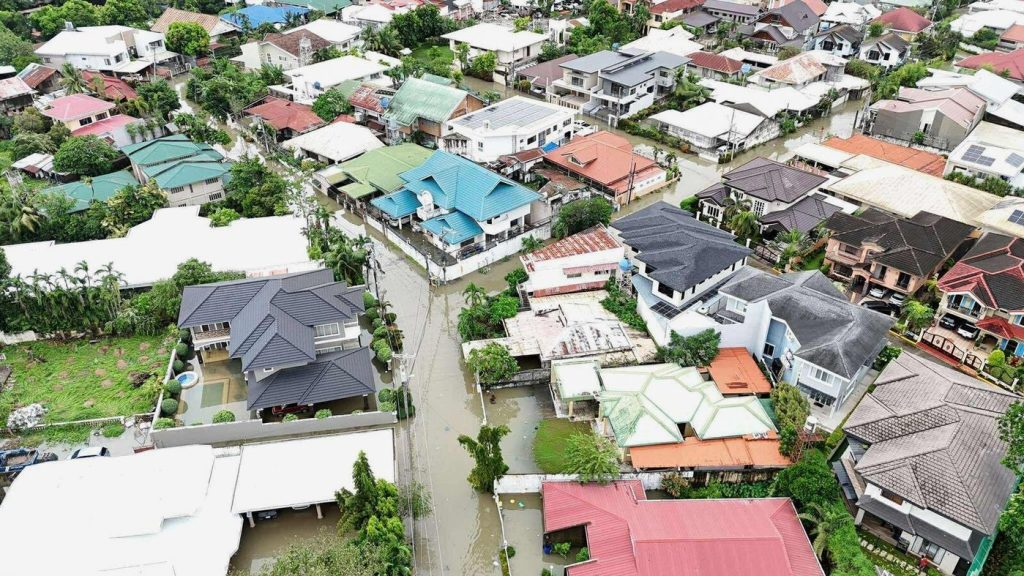MANILA, Philippines (AP) — A rapidly advancing typhoon, named Kalmaegi, hit the central Philippines Monday, wreaking havoc after making landfall from the Pacific Ocean overnight. This catastrophic weather event has already resulted in at least two confirmed fatalities, triggered flash floods that left residents stranded on rooftops, submerged vehicles in two villages, and displaced tens of thousands of individuals, according to official reports.
Typhoon Kalmaegi was reported to be passing over the city of Bacolod in the Negros Occidental province by midday, with sustained winds reaching up to 140 kilometers (87 miles) per hour and gusts as high as 195 kilometers per hour (121 mph). The storm made landfall around midnight in Silago, a town located in Southern Leyte province.
In initial reports, an elderly villager drowned in floodwaters in Southern Leyte, while another individual perished from a falling tree in Bohol province. Although these details were confirmed, further information regarding these incidents has not yet been provided.
Gwendolyn Pang, the secretary-general of the Philippine Red Cross, highlighted the desperate situation in the coastal town of Liloan in Cebu province, where residents sought refuge on their roofs due to rising floodwaters. In Mandaue City, also in Cebu, floodwaters reportedly reached head level for many individuals. Pang noted, "We have received so many calls from people asking us to rescue them from roofs and from their houses, but it’s impossible. There are so many debris. We have to wait for the flood to subside.”
Meanwhile, in Eastern Samar, one of the east-central provinces that faced the brunt of Kalmaegi on Tuesday, strong winds caused significant damage, tearing off roofs and impacting around 300 shanties in the island community of Homonhon, part of Guiuan. Fortunately, there were no reported casualties or injuries, as Mayor Annaliza Gonzales Kwan stated, "There was no flooding at all, but just strong wind. We’re OK. We’ll make it through. We’ve been through a lot, and bigger than this."
Historical context shows that Typhoon Haiyan, one of the most powerful cyclones ever recorded, devastated this region in November 2013, leading to over 7,300 fatalities and displacing millions. Kalmaegi, the 20th tropical cyclone to impact the Philippines this year, was projected to move westward at 25 kilometers per hour (16 mph) and shift into the South China Sea by late Tuesday or early Wednesday.
In preparation for the typhoon’s approach, disaster-response officials had already evacuated over 150,000 people to safer locations in eastern Philippine provinces. Authorities had issued warnings for torrential rainfall, destructive winds, and potential storm surges reaching up to 3 meters (nearly 10 feet).
This typhoon, characterized by a broad wind band spanning approximately 600 kilometers (373 miles), is set to affect various central island provinces, including Cebu, which is currently in recovery mode from a 6.9-magnitude earthquake that occurred on September 30 and caused significant damage, leaving at least 79 people dead and displacing thousands.
Additionally, concerns persist over volcanic mudflows from Mount Kanlaon, one of the Philippines' 24 active volcanoes, as heavy rains could exacerbate the situation. The Philippine Institute of Volcanology and Seismology has raised alerts as the volcano has shown increased activity in recent months.
As conditions worsened, interisland ferries and fishing vessels were prohibited from navigating the increasingly turbulent seas, leaving more than 3,500 passengers and cargo truck drivers stranded at nearly 100 seaports. At least 186 domestic flights have also been canceled due to the adverse weather.
The Philippines experiences an average of 20 typhoons annually and frequently faces earthquakes, making it one of the world’s most disaster-prone nations. As the situation unfolds, emergency services and local communities brace for further challenges as Typhoon Kalmaegi continues to impact the region.










